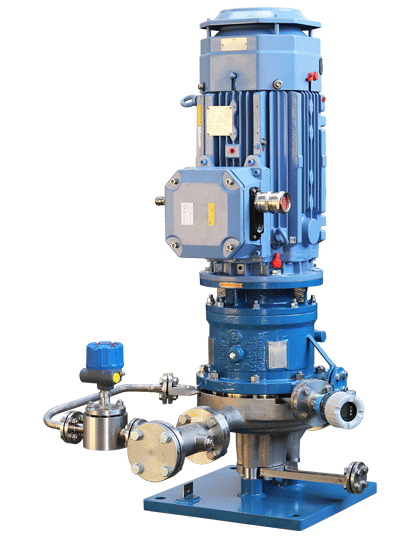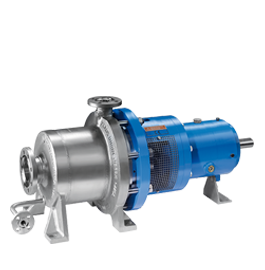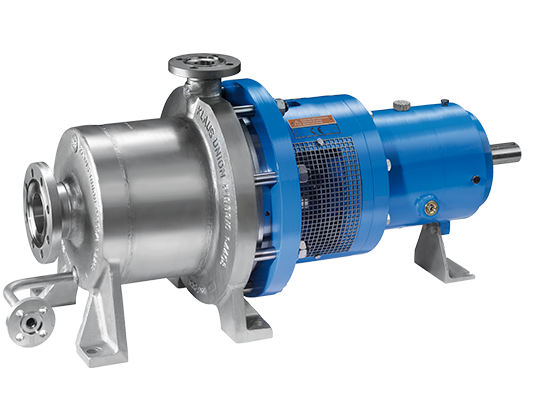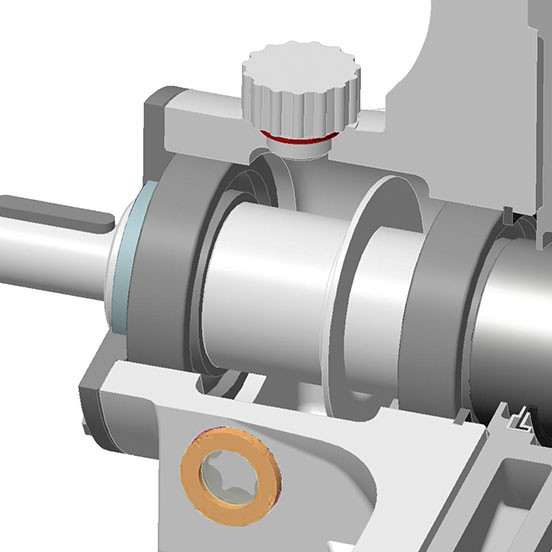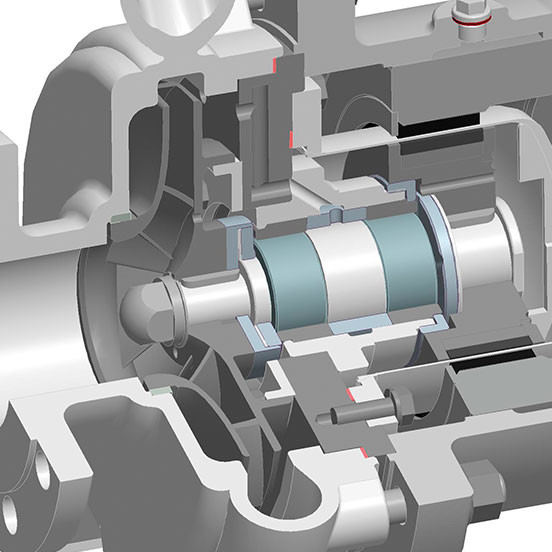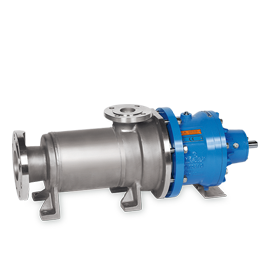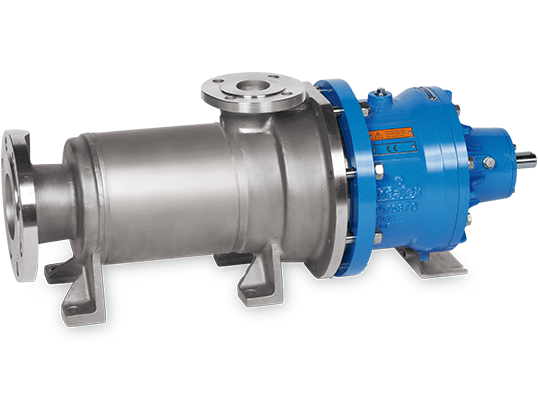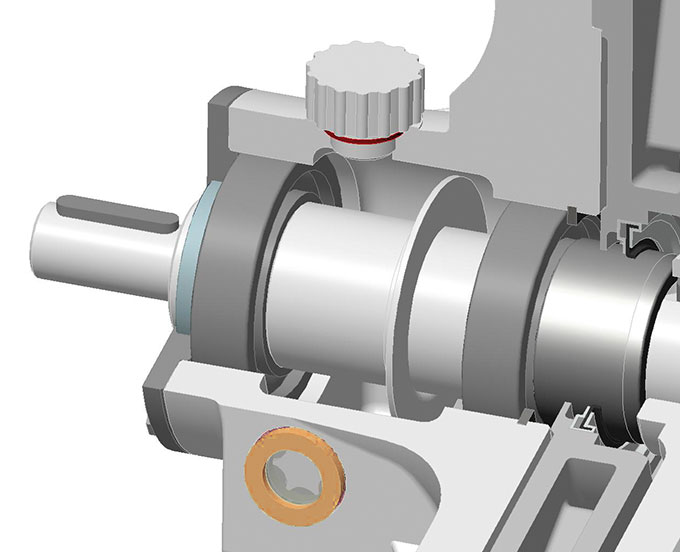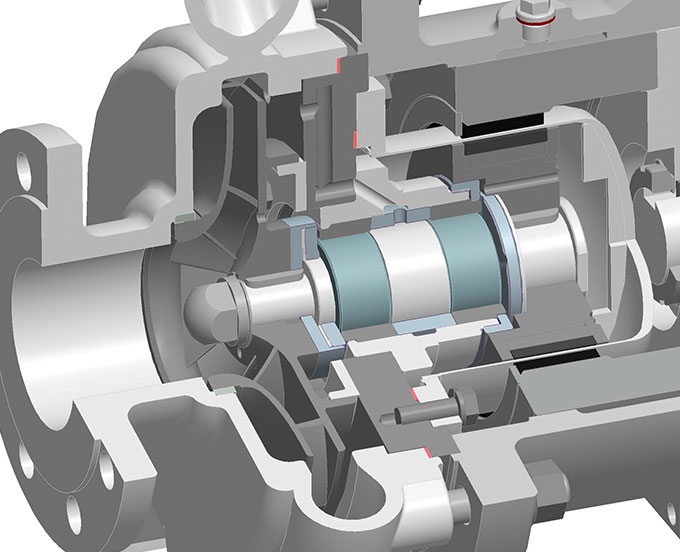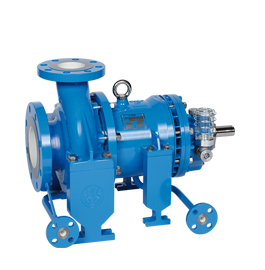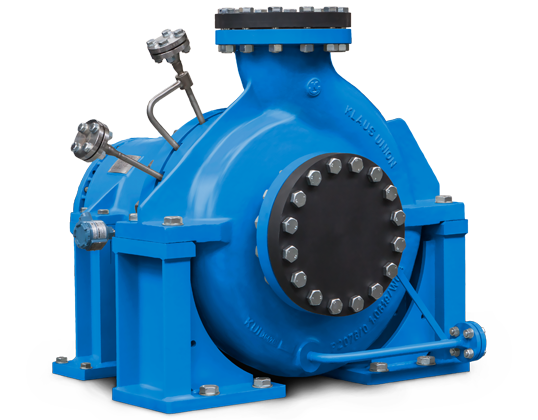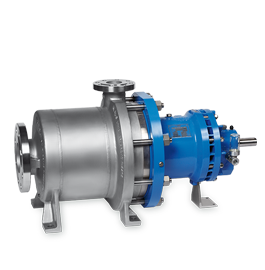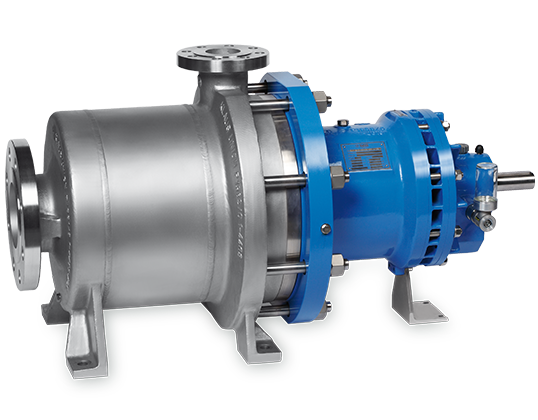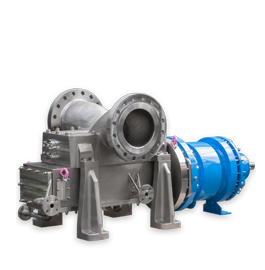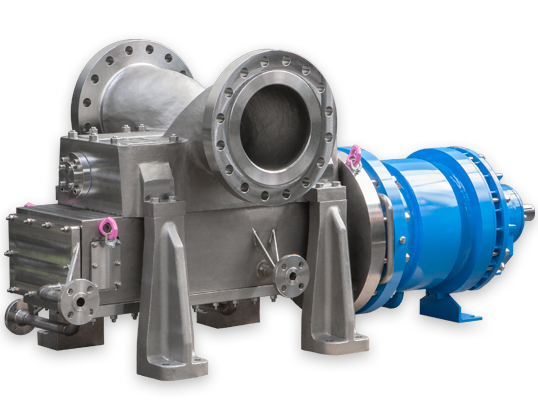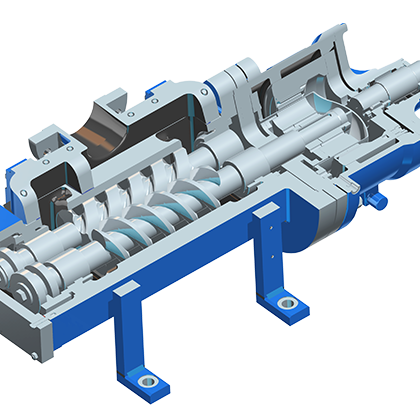Vertical Inline Pumps
max. 900 m³/h max. 220 m L.C. -120 °C bis +350 °C PN 40 bei 120 °C KEY FACTS
DESIGN PERFORMANCE RANGE Special constructions and higher outputs available TYPICAL APPLICATIONS MATERIALS
Other materials upon request, such as A9, H1, T1Flow Rate
Delivery Head
Temperature Range
Pressure Rating
Design following DIN EN ISO 15783, ASME B73.3M or API 685
Synchronous permanent magnet drive
No dynamic seals, separation of liquid chamber and atmosphere by means of isolation shellf
Secondary Control / Control System by Standard Backup Seal (Optional) acc. API 685
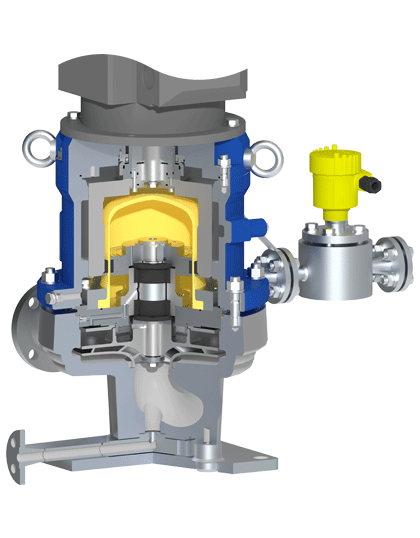






losses / lubrication of journal bearings)Optional:
Flow Rate
Q
900 m³/h
Delivery Head
H
up to 220 m L.C.
Temperature Range
t
-120 °C up to +350 °C
Pressure Rating
p
PN 40 at 120 °C
Component
S-8l
A-8
D-1
H2
Pump Casing
Carbon Steel
316 Austenite
Duplex
Hastelloy C4
Impeller
316 Austenite
316 Austenite
Duplex
Hastelloy C4
Wetted Parts
316 Austenite
316 Austenite
Duplex
Hastelloy C4
Shaft
316 Austenite
316 Austenite
Duplex
Hastelloy C4
Intermediate Lantern / Bearing Support
Carbon Steel
Carbon Steel
Carbon Steel
Carbon Steel
Case Studies
CASE STUDIES
REPLACEMENT OF A MECHANICALLY SEALED HIGH-SPEED PUMP (INTEGRAL GEAR)
Multi-stage centrifugal pump in close-coupled design with magnet drive / crude benzene / transfer
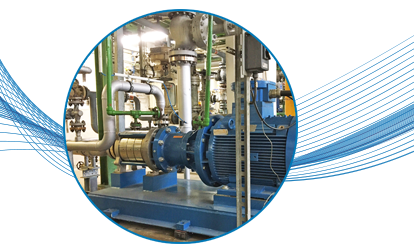
SINGLE-STAGE CENTRIFUGAL PUMP FOR A TRUCK UNLOADING APPLICATION
Dry run capable centrifugal pump in close-coupled design with magnet drive / nitric acid / truck unloading
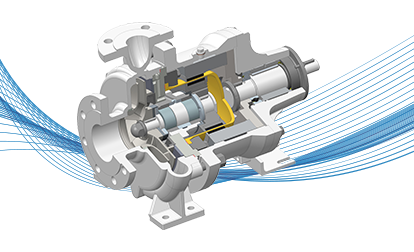
VERTICAL INLINE PUMP IN A BENZENE DRYING COLUMN
Vertical inline centrifugal pump with magnet drive / benzene / benzene drying column
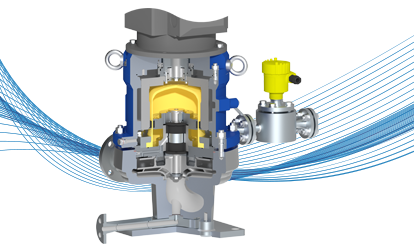
AVOIDING ANY PRODUCT CONTAMINATION
Twin screw pump with magnet drive / MDI / truck unloading
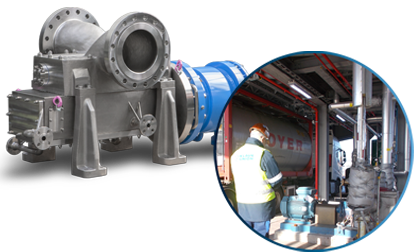
CENTRIFUGAL PUMP WITH MAGNET DRIVE IN A GAS CONDENSATE APPLICATION
Centrifugal pump with magnet drive / gas condensate / transfer
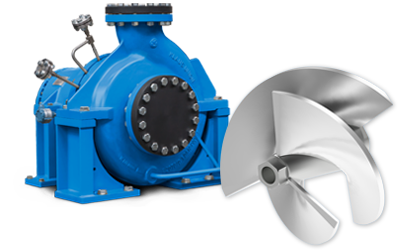
IMPROVING PUMP AVAILABILITY AND REDUCING OPEX
Twin screw pump with magnet drive / bitumen / circulation, transfer and loading
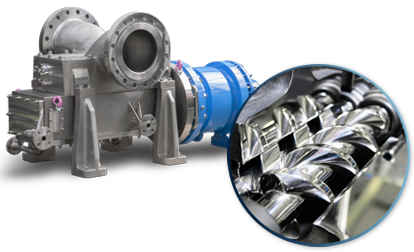
Testing
TESTING
WIDE RANGE
Customers expect the highest quality from our pumps. To ensure this, professional testing of our products to the highest standards is essential. But accurate and reliable testing is also crucial in the course of developing new products.
Klaus Union has various pump test benches that enable a wide range of tests. In this way, customer orders can be tested according to individual requirements.
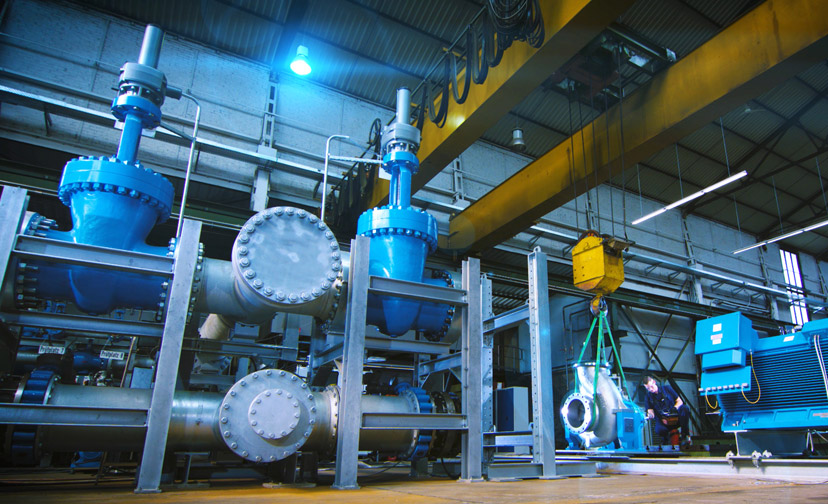
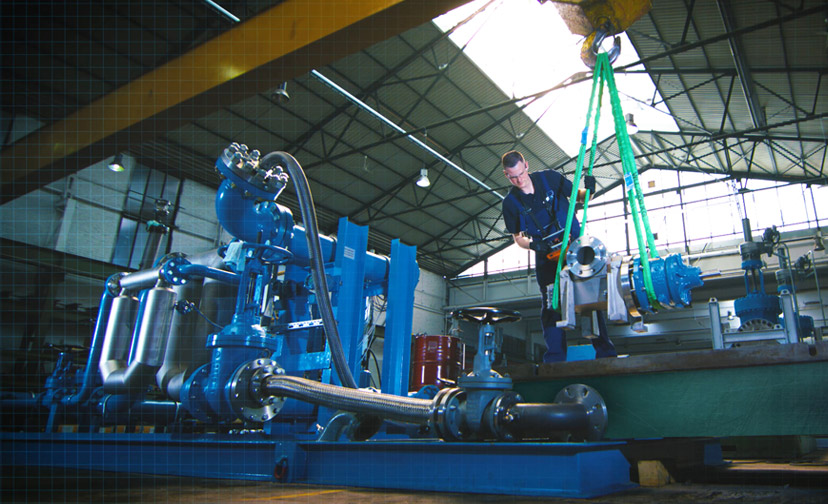
Test possibilities
- 18 test stations divided into 4 test benches
- Test with water and oil
- Frequency converter operation
- Test runs with low and medium voltage motors
- Performance of string tests
Service performance
- Testing range:
- Q = 0,1 m³/h up to 5.000 m³/h
- H = 2 m L.C. up to 1.000 m L.C.
- ΔP = up to 100 bar
- Motor power: up to 4.5 MW (2.5 MW with frequency inverter)
- n = up to 3.600 min-1
- Mechanical Running Test
- NPSH-measurements
- Axial thrust measurements
- Vibration measurement
- Noise measurement
- Temperature Measurement
NDT
- Dye Penetrant
- Radiographic (external)
- Ultrasonic (external)
MORE TEST POSSIBILITIES
- PMI
- Hydrostatic
- Hardness
- Balancing
- Visual
- Dimensional 3D
- Painting
- Leak: Air, Nitrogen, Helium (external)
- Further tests possible on request
Magnet Drive
KLAUS UNION MAGNET DRIVE
Sealless Technology
If pumps are used to handle dangerous products, it is essential to avoid even the smallest leakages into the environment in order to ensure the protection of both people and the atmosphere. The ideal solution for such a case is pumps with magnet drive. The first of its kind was introduced by Klaus Union in 1955.
Technical Description
The figure shows a cross sectional view of a pump with magnet drive The drive shaft – to transfer the mechanical energy from the drive to the pump hydraulics – is not a single shaft with a mechanical seal, gland packing or mechanical seal on it. Instead, the mechanical energy transferred from the drive to the pump shaft is transferred to an outer ring (outer magnet carrier) fitted with permanent magnets. The impeller of the centrifugal pump is firmly connected via the impeller shaft to an inner ring (inner magnet carrier) also fitted with permanent magnets. Due to the rotation of the outer magnet carrier, the inner magnet carrier is rotated synchronously via magnetic forces; the mechanical drive energy is transmitted via the magnetic field.
A containment shell is installed to separate the pumped fluid from its environment. The impeller shaft is supported by fluid-lubricated slide bearings within the pump’s hydraulic system. There are no dynamic seals between the pumped fluid and the environment from which leaks can escape to the environment. Only two static seals (designed as flat seals or O-rings) are used between pump casing and casing cover and between casing cover and containment shell in the magnetically driven pump. The static seals are maintenance free and therefore the pump is hermetically sealed.
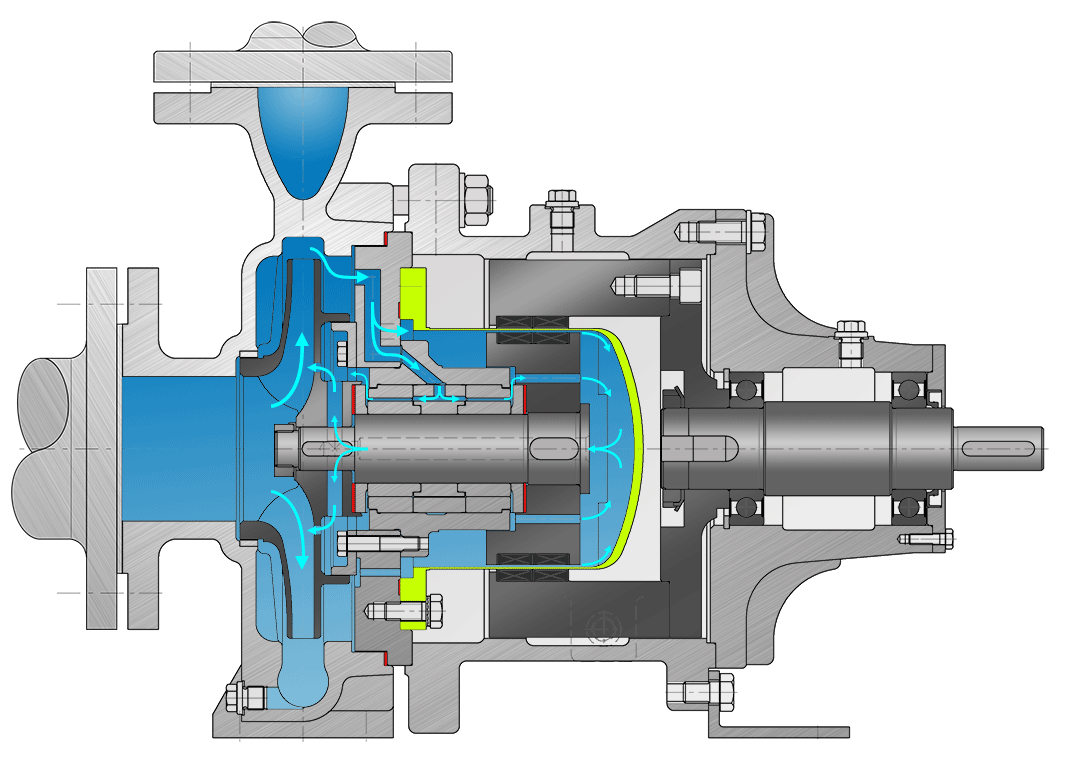
Advantages vs. Mechanically Sealed Pumps
- Nearly maintenance free
- Less investment costs and less maintenance costs
- No instrumentation or special monitoring devices required in standard
- No utilities required, such as nitrogen or cooling water
- No leakage to the atmosphere
- No loss of sealant liquid
- No wear of the seals at all
- Low mechanical loads on shaft and bearings
- High stiffness of the pump shaft
Advantages vs. Canned Motor Pumps
- Standard IEC and NEMA motors can be used
- Lower investment and repair costs
- Separate flushing of journal bearing
- Higher efficiency
- Use of non- metallic containment shell possible
- No heat generation of the rotor by electric losses
- Higher viscosities possible
- Higher temperatures without cooling possible
- No special monitoring devices necessary
Technical Developments
TECHNICAL DEVELOPMENTS
PULLOUT DESIGN FOR VERTICALLY SUSPENDED (SUMP) PUMPS WITH MAGNET DRIVE
Clean and safe maintenance of vertically suspended (sump) pumps with magnet drive
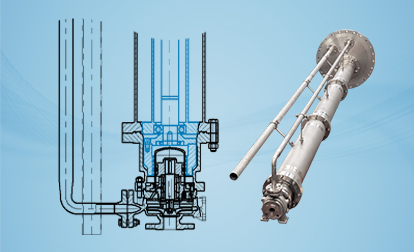
TEMPERATURE MONITORING SYSTEM (TPX)
To further optimize the process reliability of Klaus Union’s magnetically coupled pumps, the TPX temperature monitoring system enables accurate and instantaneous measurement of the containment can temperature.
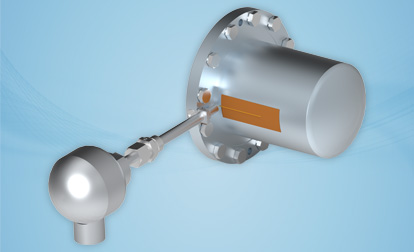
HYBRID DOUBLE CONTAINMENT SHELL
To reduce the heat generated by a purely metallic, double containment shell and at the same time to improve the overall efficiency of the pump, Klaus Union has developed and patented a new hybrid double containment shell.
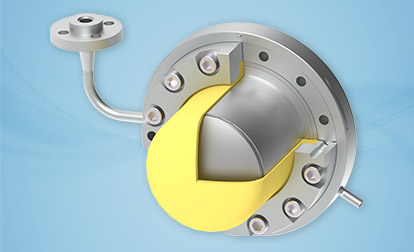
Secondary mechanical seal
Secondary mechanical seal as a cost efficient additional layer of safety for magnetic coupled pumps in particularly hazardous applications.
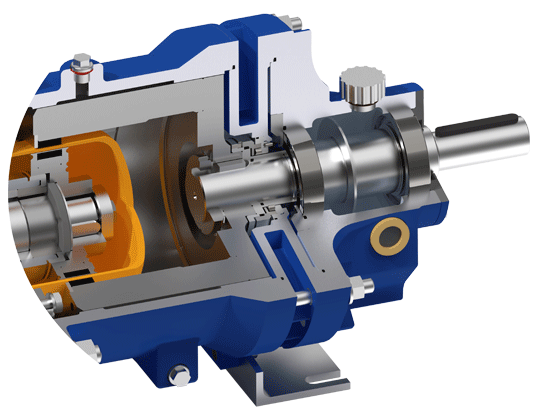
Non-Metallic Containment Shells
Through the use of non-metallic containment shells instead of the traditionally used metallic containment shells, Klaus Union eliminates eddy current losses and increases the efficiency of magnet drive pumps significantly.
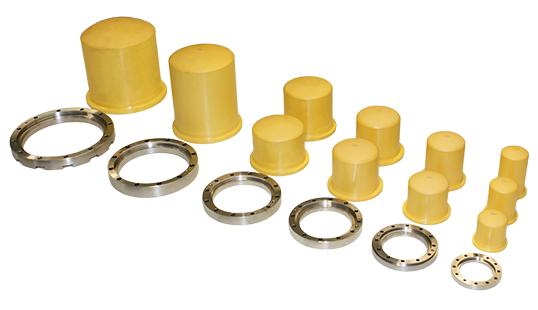
Dry Running Design
For the case of a flow interruption, Klaus Union has developed the RTZ Design for magnet drive centrifugal pumps.
Pumps according to this special design conveying water-like media can handle a dry run on suction side for up to 10 minutes. The increase of the containment shell surface temperature is relatively slight.
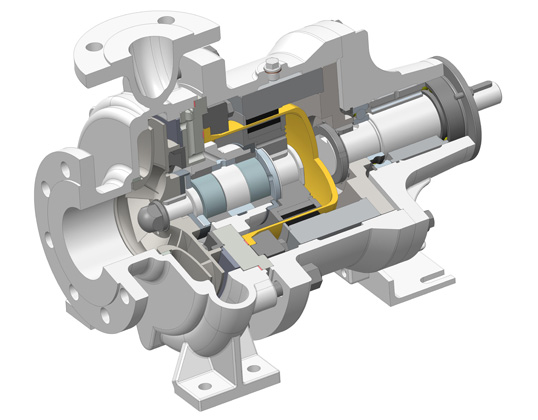
Handling Liquids Containing Solids
Available design features for magnetically coupled centrifugal pumps to safely handle liquids containing solids.
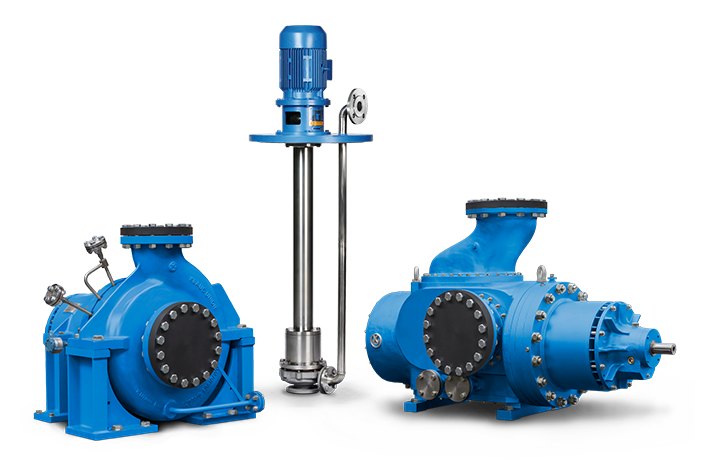
Greased-for-life Lubrication
Effective from August 1, 2016, Klaus Union offers greased- for-life antifriction bearings (2Z/WT: two sealing discs) for pumps with grease lubricated drive frame as a standard.
The upgrade does not incur a cost adder. It provides various benefits for customers.
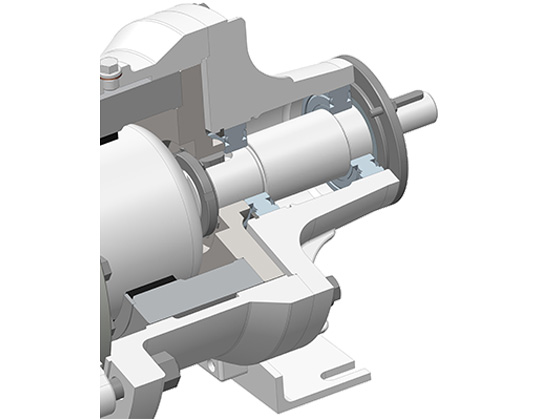
GOV/H
max. 300 m³/h max. 2.200 m L.C. -120 °C to +350 °C max. 250 PN key facts
DESIGN OPERATING RANGE Special configurations available up to PN 400. Higher outputs available. TYPICAL APPLICATION CUSTOM MATERIALS Further materials upon request. IDENTIFICATION CODE: max. 540 m³/h max. 1.300 m -40 °C to + 180 °C max. 100 PN key facts
DESIGN OPERATING RANGE Special configurations available up to PN 400. Higher outputs available. TYPICAL APPLICATION CUSTOM MATERIALS Further materials upon request. IDENTIFICATION CODE: DESIGN VARIANTS The pumps are outfitted with a heat jacket and pump casing (H1) and/or a heat jacket in the bearing lantern (H2). Both heat jackets can be realized either separately or in conjunction with a bypass line. The heat jackets in the standard construction are rated for operating pressure of 16 bar at 200 °C (steam) or 6 bar at 350 °C. The heat jackets can also be used for cooling. Inducers are often used in cases where the installation’s NPSH values are extremely low. Inducers substantially reduce pump NPSH throughout the installation without altering pump characteristics. Inducer J can be retrofitted on existing pumps, in most cases with only a minimum amount of pump modification. NACHSETZZEICHEN (AUSFÜHRUNGEN):Flow Rate
Delivery Head
Temperature Range
Pressure Rating
Design according to DIN EN ISO 5199
Modular System
Shaft Seal Packing; Single or Double Mechanical Seal (also available as a Cartridge Unit)
Heating for Casing and Casing Cover available
Mechanical Seal-Cover available
Design based on API 610 available on Request
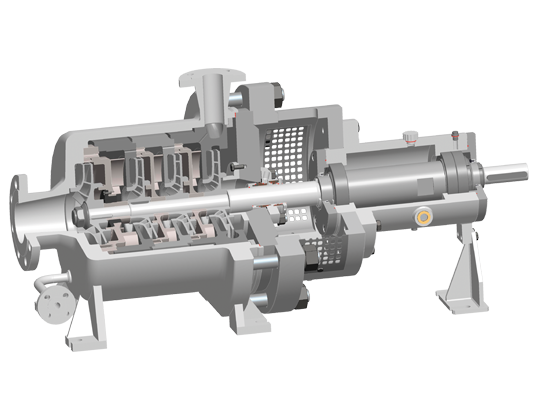






Flow Rate
Q
300 m³/h
Delivery Head
H
max. 2.200 m
Temperature Range
t
-120 °C to +350 °C
Pressure Rating
p
max. PN 250
Pump casing:
1.4408 or 1.0619
Impeller:
1.4408
Casing cover:
1.4571
Shaft:
1.4462
Shaft Sheath:
1.4571
Bearing lantern:
1.0619
Bearing carrier:
0.7043
Shaft seal:
Acc. to product and/or customer specifications
Bearing carrier
Realization
Comments
NOV
Standard
Oiled, with deep Groove Ball Bearing
Flow Rate
Delivery Head
Temperature Range
Pressure Rating
Design according to DIN EN ISO 5199
Modular System
Shaft Seal Packing; Single or Double Mechanical Seal (also available as a Cartridge Unit)
Heating for Casing and Casing Cover available
Mechanical Seal-Cover available
Impellers in Pairs or Back-to-Back; max. 6 Stages
Design based on API 610 available on Request







Flow Rate
Q
540 m³/h
Delivery Head
H
max. 1.300 m
Temperature Range
t
-40 °C to +180 °C
Pressure Rating
p
max. PN 100
Pump casing:
1.4408 or 1.0619
Impeller:
1.4408
Casing cover:
1.4571
Shaft:
1.4462
Shaft Sheath:
1.4571
Bearing lantern:
1.0619
Bearing carrier:
0.7043
Shaft seal:
Acc. to product and/or customer specifications
Bearing carrier
Realization
Comments
NOV
Standard
Oiled, with deep Groove Ball Bearing
H1
heated pump casing
H2
jacketed bearing lantern
J
inducer
SLM SV
max. 42 m³/h max. 470 m L.C. -120 °C to +250 °C max. PN 400 KEY FACTS
DESIGN OPERATING RANGE Higher flow rates upon request. TYPICAL APPLICATION CUSTOM MATERIALS Further materials upon request. max. 42 m³/h max. 470 m -120 °C to +300 °C max. PN 400 key facts
DESIGN OPERATING RANGE Higher flow rates upon request TYPICAL APPLICATION CUSTOM MATERIALS
NACHSETZZEICHEN (AUSFÜHRUNGEN): DESIGN VARIANTS The pumps are outfitted with a heat jacket and pump casing (H5) and/or a heat jacket in the bearing lantern (H2). Both heat jackets can be realized either separately or in conjunction with a bypass line. The heat jackets in the standard construction are rated for operating pressure of 16 bar at 200 °C (steam) or 6 bar at 350 °C. The heat jackets can also be used for cooling. The thermal barrier acts as a structural element between the bearing carrier (in the bearing carrier model) or drive motor (in the close coupled model), whereas the hydraulic system allows for heat transfer. This reduces ball bearing temperatures in the gearing when hot liquids are being transported. A radial shaft sealing ring can also be integrated into the thermal barrier for purposes of sealing the magnet driver. The sealing ring acts as a secondary seal that prevents the product from leaking into the environment through a leak in the isolation shell. In order for this secondary seal to be used, the magnet driver chamber must be monitored so that leaks can be detected in good time. The double isolation shell should be used in situations requiring a high level of safety. The unit consists of two interlocking isolation shells, both of which are rated for the relevant operating conditions. If one of the two units is damaged, the casing still remains leaktight. The gap between the two units can be monitored. Flow Rate
Delivery Head
Temperature Range
Pressure Rating
Design according to DIN EN ISO 15783
Maintenance-Free Permanent Magnet Drive
Modular Design
No Dynamic Seal, Separation of Liquid Chamber and Atmosphere by Means of Containment Shell
Barrel Design Version with only two static Seals
Impeller Arrangement in Series; max. 8 Stages
Self-Priming; First Low-NPSH Stage for Improved Suction Performance
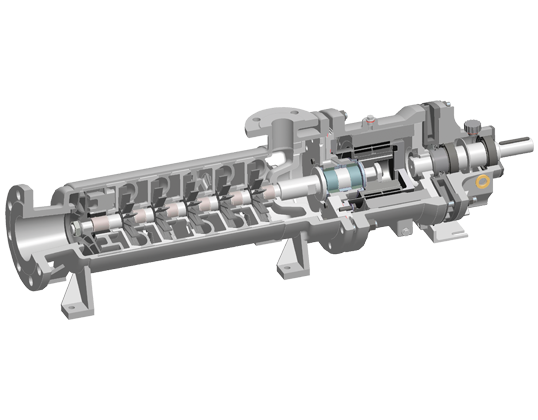










FLOW RATE
Q
42 m³/h
DELIVERY HEAD
H
max. 470 m L.C.
TEMPERATURE
t
-120 °C to +250 °C
PRESSURE RATING
p
max. PN 400
Casing elements:
315 SS
Impeller/Paddle wheels:
316 SS
Containment shell:
316 Ti/Hastelloy C4
Magnet carrier:
316 Ti
Radial journal bearings:
Silicon Carbide
Intermediate lantern:
Nodular Iron
Bearing carrier:
Ductile Iron
Flow Rate
Delivery Head
Temperature Range
Pressure Rating











Flow Rate
Q=
42 m³/h
Delivery Head
H=
max. 470 m
Temperature Range
t=
-120 °C bis +300 °C
Pressure Rating
p=
max. PN 400
Gehäuseteile:
1.4408
Laufrad/Flügelräder:
1.4408
Spalttopf:
1.4571/2.4610
Magnetträger:
1.4571
Gleitlagerung:
Siliciumcarbid
Zwischenlaterne:
1.0619
H1
heated pump casing
H2
jacketed bearing lantern
S
thermal barrier without secondary seal
W
thermal barrier with secondary seal
SLM AP
max. 3.500 m³/h max. 220 m L.C. -120 °C to +450 °C max. PN 400 KEY FACTS
DESIGN OPERATING RANGE Special constructions and higher outputs are available TYPICAL APPLICATION CUSTOM MATERIALS Further materials such as the following are available: H-2 (Hastelloy C), A-9 (Alloy-20), T-1 (Titanium), D-1 (Duplex). max. 3.500 m³/h max. 220 m -120 °C to +350 °C max. PN 400 key facts
DESIGN OPERATING RANGE Special constructions and higher outputs are available TYPICAL APPLICATION CUSTOM MATERIALS Further materials such as the following are available: H-2 (Hastelloy C), A-9 (alloy-20), T-1 (titanium), D-1 (duplex). NACHSETZZEICHEN (AUSFÜHRUNGEN): DESIGN VARIANTS The pumps are outfitted with a heat jacket and pump casing (H1) and/or a heat jacket in the bearing lantern (H2). Both heat jackets can be realized either separately or in conjunction with a bypass line. The heat jackets in the standard construction are rated for operating pressure of 16 bar at 200 °C (steam) or 6 bar at 350 °C. The heat jackets can also be used for cooling. When solids-containing liquids are being transported, the internal filter prevents inadmissibly large particles from entering the flow channels, and from there the magnetic coupling and internal bearings. These external connections allow for external flushing, feeding and/or venting. Connection E1 is used in situations where a continuous feed into the magnet drive is desired. Connection E2 is used suitable for short-term flushing, or for external venting of the magnetic coupling. The double isolation shell should be used in situations requiring a high level of safety. The unit consists of two interlocking isolation shells, both of which are rated for the relevant operating conditions. If one of the two units is damaged, the casing still remains leaktight. The gap between the two units can be monitored. Inducers are often used in cases where the installation’s NPSH values are extremely low. Inducers substantially reduce pump NPSH throughout the installation without altering pump characteristics. Inducer J can be retrofitted on existing pumps, in most cases with only a minimum amount of pump modification.Flow Rate
Delivery Head
Temperature Range
Pressure Rating
Design according to API 685 2nd Edition
Maintenance-Free Permanent Magnet Drive
Modular Design
No Dynamic Seal, Separation of Liquid Chamber and Atmosphere by Means of Containment Shell
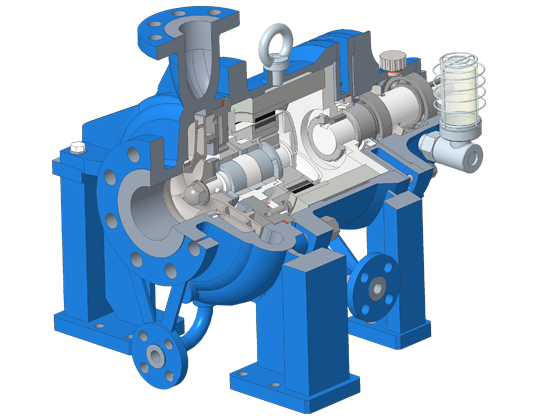








Flow Rate
Q
3.500 m³/h
Delivery Head
H
max. 220 m L.C.
Temperature Range
t
-120 °C to +450 °C
Pressure Rating
p
max. PN 400
Component
A-8
S-8
Pump casing
316 austenite
Cast steel
Impeller
316 austenite
316 austenite
Containment shell
Hastelloy C
Hastelloy C
Pump shaft
316 austenite
316 austenite / C-steel
Intermediate lantern / Bearing carrier
Cast steel
Cast steel
Drive shaft
C-steel
C-steel
Flow Rate
Delivery Head
Temperature Range
Pressure Rating
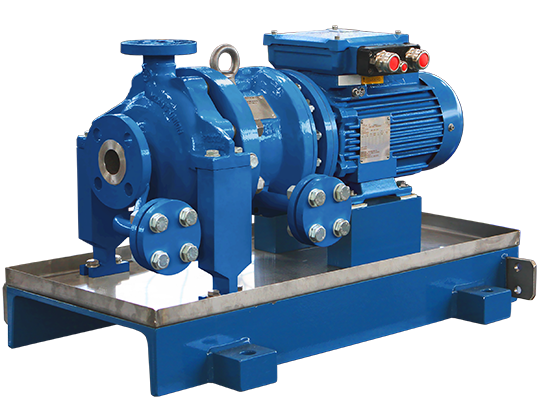








Flow Rate
Q=
3.500 m³/h
Delivery Head
H=
max. 220 m
Temperature Range
t=
-120 °C to +350 °C
Pressure Rating
p=
max. PN 400
Component
A-8
S-8
Pump casing
316 austenite
Cast steel
Impeller
316 austenite
316 austenite
Containment Shell
Hastelloy C
Hastelloy C
Pump shaft
316 austenite
316 austenite / C-steel
Bearing lantern/bearing carrier
Cast steel
Cast steel
Drive shaft
C-steel
C-steel
H1
beheiztes Pumpengehäuse
H2
beheizte Zwischenlaterne
F
Innenfilter
E1
externe Einspeisung, interne Teilstrombohrungen verschlossen
E2
externe Spülung / Entlüftung, interne Teilstrombohrungen offen
E1F
externer Teilstrom mit Hauptstromfilter nach DGRL
D
Doppelschaliger Spalttopf
J
Inducer
SLM GV/HV
max. 300 m³/h max. 2.200 m L.C. -120 °C to +350 °C max. PN 250 key facts
DESIGN OPERATING RANGE TYPICAL APPLICATION CUSTOM MATERIALS max. 360 m³/h max. 580 m -40 °C to +250 °C max. PN 63 KEY FACTS
DESIGN OPERATING RANGE TYPICAL APPLICATION CUSTOM MATERIALS max. 540 m³/h max. 1.300 m -40 °C to +180 °C max. PN 100 KEY FACTS
DESIGN OPERATING RANGE TYPICAL APPLICATION CUSTOM MATERIALS max. 350 m³/h max. 700 m -120 °C to +300 °C max. PN 200 key facts
DESIGN OPERATING RANGE TYPICAL APPLICATION CUSTOM MATERIALS NACHSETZZEICHEN (AUSFÜHRUNGEN): DESIGN VARIANTS The pumps are outfitted with a heat jacket and pump casing (H1) and/or a heat jacket in the bearing lantern (H2). Both heat jackets can be realized either separately or in conjunction with a bypass line. The heat jackets in the standard construction are rated for operating pressure of 16 bar at 200 °C (steam) or 6 bar at 350 °C. The heat jackets can also be used for cooling. When solids-containing liquids are being transported, the internal filter prevents inadmissibly large particles from entering the flow channels, and from there the magnetic coupling and internal bearings. These external connections allow for external flushing, feeding and/or venting. Connection E1 is used in situations where a continuous feed into the magnet drive is desired. Connection E2 is used suitable for short-term flushing, or for external venting of the magnetic coupling. The double isolation shell should be used in situations requiring a high level of safety. The unit consists of two interlocking isolation shells, both of which are rated for the relevant operating conditions. If one of the two units is damaged, the casing still remains leaktight. The gap between the two units can be monitored. Inducers are often used in cases where the installation’s NPSH values are extremely low. Inducers substantially reduce pump NPSH throughout the installation without altering pump characteristics. Inducer J can be retrofitted on existing pumps, in most cases with only a minimum amount of pump modification. Flow Rate
Delivery Head
Temperature Range
Pressure Rating
Design according to DIN EN ISO 15783
Maintenance-Free Permanent Magnet Drive
Modular Design
No Dynamic Seal, Separation of Liquid Chamber and Atmosphere by Means of Containment Shell
Barrel Design Version without Variable Seal
Impeller Arrangement in Series; max. 15 Stages
First Low-NPSH Stage for Improved Suction Performance
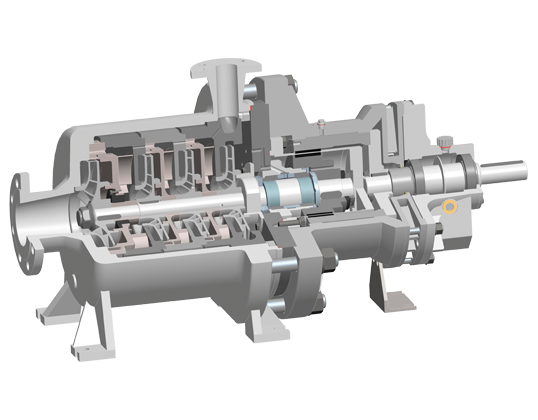










Flow Rate
Q
300 m³/h
Delivery Head
H
max. 2.200 m L.C.
Temperature Range
t
-120 °C to +350 °C
Pressure Rating
p
max. PN 250
Flow Rate
Delivery Head
Temperature Range
Pressure Rating
Design according to DIN EN ISO 15783
Maintenance-Free Permanent Magnet Drive
Modular Design
No Dynamic Seal, Separation of Liquid Chamber and Atmosphere by Means of Containment Shell
Tension Rod Version with Variable Seal
Impeller Arrangement in Series; max. 6 Stages
First Low-NPSH Stage for Improved Suction Performance
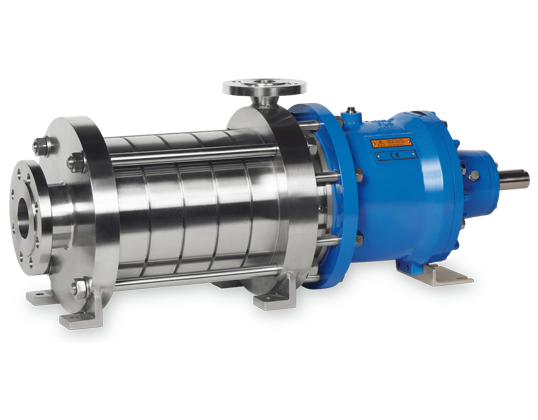








Flow Rate
Q
350 m³/h
Delivery Head
H
max. 700 m
Temperature Range
t
-120 °C to +350 °C
Pressure Rating
p
max. PN 200
Flow Rate
Delivery Head
Temperature Range
Pressure Rating
Design according to DIN EN ISO 15783
Maintenance-Free Permanent Magnet Drive
Modular Design
No Dynamic Seal, Separation of Liquid Chamber and Atmosphere by Means of Containment Shell
Impellers in Pairs or back-to-back; max. 6 Stages
First Low-NPSH Stage for Improved Suction Performance
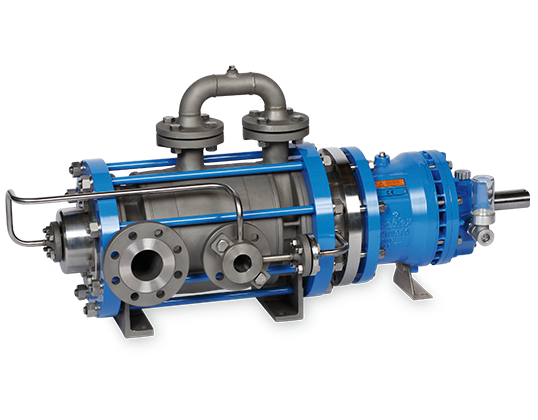






Flow Rate
Q
540 m³/h
Delivery Head
H
max. 1.300 m
Temperature Range
t
-40 °C to +180 °C
Pressure Rating
p
max. PN 100
Flow Rate
Delivery Head
Temperature Range
Pressure Rating









Flow Rate
Q
350 m³/h
Delivery Head
H
max. 700 m
Temperature Range
t
-120 °C bis +300 °C
Pressure Rating
p
max. PN 200
H1
heated pump casing
H2
jacketed bearing lantern
S
thermal barrier without secondary seal
W
thermal barrier with secondary seal
F
internal filter
E1
external feeding, internal secondary-flow boring non-enclosed
E2
external flushing and vening; internal secondary-flow non-enclosed
E1F
external secondary flow with main flow filter per DGRL
J
inducer
SLM DSP-2C
max. 1.800 m³/h max. 40 bar -120 °C to +350 °C max. PN 400 KEY FACTS
DESIGN OPERATING RANGE Higher Flow Rates upon Request Higher Pressure Ratings upon Request TYPICAL APPLICATION CUSTOM MATERIALS Upon Request, Klaus Union Screw Pumps, Series SLM DSP-2C, can be supplied also in Hastelloy, Inconel, other High Nickel Alloys or Titanium.Flow Rate
Differential Pressure
Temperature Range
Pressure Rating
According to API 676, 3rd Edition
Maintenance-Free Permanent Magnet Drive
Modular Design
Cartridge Design
Modular Construction (Multi-Part-Casing)
Adaptive Feet with Centerline Mounting
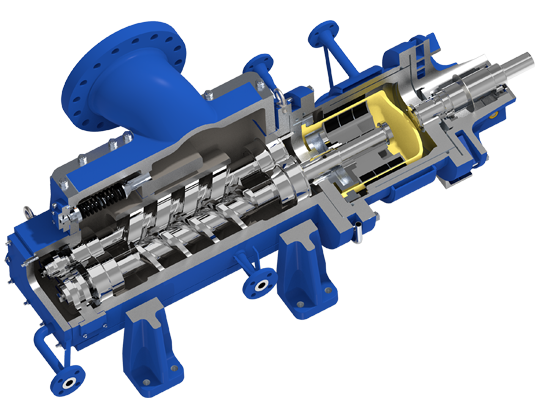










Performance Range
Flow Rate
Q= max. 1.800 m³/h
Differential Pressure
P= max. 40 bar
Viscosity
max. 100.000 mm²/s (cSt)
Pressure Ratings
Standard Construction
PN 25 at +120 °C
Temperature Range
t= -120 °C to +350 °C
Pressure Rating
P= max. PN 400
Pump Casing
Cast Carbon Steel; Cast Stainless Steel; Duplex Stainless Steel;
Super Duplex Stainless Steel
Liner
Cast Carbon Steel; Cast Stainless Steel;
Duplex Stainless Steel;
Super Duplex Stainless Steel;
Wear Resistant Coating
Rotors
Carbon Steel, nitrated;
Martensitic Stainless Steel, nitrated;
Stainless Steel, hardened;
Duplex Stainless Steell, hardened;
Wear Resistant Coating
Containment Shell
Hastelloy C; Titanium; Alloy 718; Zirkonium Oxide
DESIGN VARIANTS
A heat jacket (H3) around the bearing lantern causes a heating of the magnet drive.
The pumps are outfitted with a foot heating (H4) and/or a heat jacket in the bearing lantern (H2). Both can be realized either separately or in conjunction with a bypass line. Both heating systems are rated for operating pressure of 16 bar at 200 °C (steam) or 6 bar at 350 °C in the standard construction. They can also be used for cooling.
The thermal barrier acts as a structural element between the bearing carrier (in the bearing carrier model) or drive motor (in the close coupled model), whereas the hydraulic system allows for heat transfer. This reduces ball bearing temperatures in the gearing when hot liquids are being transported. A radial shaft sealing ring can also be integrated into the thermal barrier for purposes of sealing the magnet driver. The sealing ring acts as a secondary seal that prevents the product from leaking into the environment through a leak in the isolation shell. In order for this secondary seal to be used, the magnet driver chamber must be monitored so that leaks can be detected in good time.
When solids-containing liquids are being transported, the internal filter prevents inadmissibly large particles from entering the flow channels, and from there the magnetic coupling and internal bearings.
This isolation shell generates no Eddy Current losses in the magnet drive. This isolation shell offers maximum pump effi ciency and is particularly benefi cial where heat input into the pumped liquid is to be avoided.
The plastic isolation shell consists of two separate components â?? a carbon fi bre reinforced outer shell, and an inner PTFE liner. The shell eliminates Eddy Current losses and is used to maximise the pumpâ??s over-all efficiency, or when a temperature rise of the internal flush flow must be avoided.
These external connections allow for external flushing, feeding and/or venting. Connection E1 is used in situations where a continuous feed into the magnet drive is desired. Connection E2 is used suitable for short-term flushing, or for external venting of the magnetic coupling.
The self-cleaning discharge fi lter is used for applications where liquids with a moderate percentage of solids are handled. The flush flow is picked up externally from the discharge filter and re-introduced into the magnet coupling. The internal flush flow ports are closed.
This construction type is used for applications where liquids with a high percentage of solids are handled. The casing cover is equipped with two external connections for feeding and draining of the isolation shell area. The specially designed journal bearings prevent any solids within the pumped liquid from entering the magnet drive.
The double isolation shell should be used in situations requiring a high level of safety. The unit consists of two interlocking isolation shells, both of which are rated for the relevant operating conditions. If one of the two units is damaged, the casing still remains leaktight. The gap between the two units can be monitored.
The secondary sealing consists of a highperformance radial shaft seal ring, which ensures that there is no immediate leakage of the liquid to the atmosphere in the drive shaft area in the event of an isolation shell failure.


